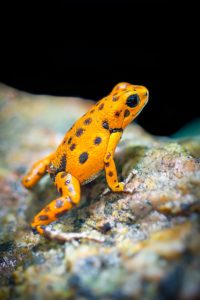Welcome to this article about poison dart frogs! These amphibians are most noted for being one of the most toxic species of animals in the world. They come in a wide range of brilliant and vivid colors as well. Join us as we take a look at some facts behind the astounding poison dart frog!

Scientific and Physical Characteristics
- The poison dart frog is actually a name common to over 170 species of toxic frogs of the family
- They are commonly known as ‘poison dart frogs’ as indigenous tribes would harvest the poison from these frogs and use it to create poison darts and blow darts as weaponry.
- The majority of dart frog species are small, often growing as small as 1 inch, while a few other species have been observed to grow up to 2.5 inches.
- Their most distinctive feature is the vividly colored skin with intricate patterns. This is a result of a trait known as aposematism which is a warning of toxicity towards predators. This coloration is typically associated with the amount of toxic levels in their body.
- However, not all poison dart frogs are toxic! Some species have cryptic coloration, which is a more basic and blander skin color that is associated with minimal to no levels of toxicity.
Habitat and Distribution
- Poison dart frogs are exclusive and endemic to the rainforests of Central and South America, particularly in countries such as Costa Rica, Panama, Brazil, Colombia, and Peru.
- They require high humidity levels in their environment.
- The natural habitat of a poison dart frog includes tropical rainforests, shrublands, rivers, freshwater marshes, and swamp areas.
- This habitat choice varies according to the species. Certain species have been discovered in plantations, wet grasslands, rocky areas, and even rural gardens.
- In the wild, these frogs typically spend more time on the ground and on the trees. This explains why poison dart frogs have flat, wide toes compared to a normal frog which has webbed feet (that is evolved for swimming).
- Eggs are often laid in moist environments such as leaves and roots.
Diet and Behavior
- Poison dart frogs usually have a similar diet to a typical frog and will feed on numerous types of small invertebrates. This can include flies, ants, beetles, caterpillars, and other insect species.
- Highly toxic species of frogs will usually survive on mites, ants and smaller invertebrates while the less toxic (cryptic colored) species will feed on larger invertebrates.
- The majority of poison dart frog species are diurnal which means they tend to be most active during the day as opposed to the night.
- Fertilization of eggs is carried out externally where the female will initially lay her eggs and the male will fertilize them afterwards.
- These frogs are known for being committed parents towards their offspring. They are noted for carrying the tadpoles on their back towards suitable water sources where the offspring will remain until metamorphosis. Young tadpoles are fed with smaller invertebrates or unfertilized eggs.
- Poison dart frogs have also been observed to engage in ‘wrestling matches’ as a means of securing territory and establishing dominance. Therefore, these animals happen to be one of the rare species of frogs that have a territorial nature.
Other Interesting Facts about Poison Dart Frogs
- When considering the poison that these frogs are known for, they mostly secrete alkaloid toxins through their skin.
- The most toxic species of the poison dart frogs are the Phyllobates terribilis or the Golden Poison frog.
- The Golden Poison frog has enough toxic alkaloid levels in its body to kill up to twenty humans.
- A theory as to how these frogs are poisonous is thought to be due to their ability to extract the poison from their prey such as ants and centipedes. This would explain why frogs raised in captivity do not have the same level of toxicity as their natural counterparts as they do not have the same diet.
- Scientists have extracted and used these toxins of the poison dart frogs for medicinal purposes. For example, a painkiller was created from the Epibatidine toxin which is supposedly 200 times more effective than simple morphine. Other uses of toxins have included heart stimulants and appetite suppressants, but these come with specific side issues due to their toxicity.
- Poison dart frogs are capable of being raised in captivity but require high humidity and tropical temperatures in order to survive. In captivity, they have been observed to live for varying periods of time ranging from 3 years to 25 years at the very most.
- The majority of poison dart frog species are threatened or endangered, particularly due to habitat loss by deforestation and amphibious infections (such as chytrid diseases). They have also been collected for the pet trade (which requires extra appropriate care as they can retain their poison for some time).
I hope that you enjoyed reading these facts about poison dart frog. If you want to learn about other animals, visit animal facts page.
